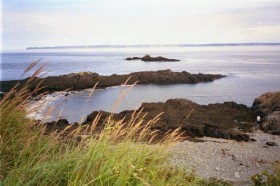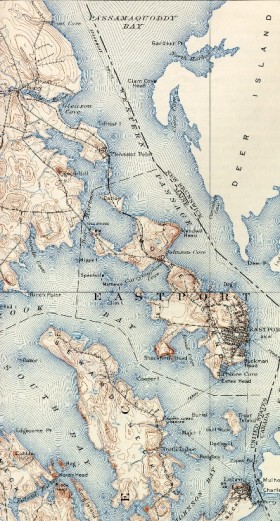“Quoddy is an example of a project planned by private capital and supported by pressure groups, but which could not be financed without public aid.”
So noted Lincoln Smith in his analysis of the long-studied but never funded tidal hydroelectric project in Washington County. Conceived in the early 20th century by Dexter P. Cooper, the project was expected to cost $75-100 million in the 1920’s to generate about 3 billion kilowatt hours per year.
“Quoddy” was to span Passamaquoddy Bay in Canada and Cobscook Bay in Washington County. However, after an initial interest, the Canadian government withdrew permission when fishermen protested the loss of valued fishing grounds.
During the Great Depression, the Public Works Administration (PWA) was seeking projects to create employment. But the Federal government determined that Quoddy was too expensive and could not compete with cheaper power from a steam plant.
Nevertheless, with Democratic Governor Louis J. Brann championing the idea, and a sympathetic Democratic President, Franklin Roosevelt in office, by 1935 several million dollars was allocated and spent by the Army Corps of Engineers in preliminary studies and tests. Again, hopes dimmed as funding was cut by Congress completely in 1936.
A major problem in promoting the project was the lack of a clear market for the power it might produce. Several schemes were advanced for transmitting the power across the country and inconclusive market studies impressed few.
Lincoln Smith summarized the political aspects of the project as follows:
The Democrats actively supported the project in Maine, but the Republicans as a party did not. While the Democrats incorporated a Quoddy plank in their platform, the Republicans refused to do so. However, the Maine Senators, Congressmen, Governors, and many members of the state legislature gave their support to the project. Some frankly considered it “pork barrel” legislation and felt that Maine should come in for its share. (pp. 248-249)
See the Democratic platforms of 1934, 1936, 1938, and 1950 and many years thereafter. Beginning in 1950, even the Republican platforms supported the idea and continued to do so through the 1970’s. In the 1960’s, a brief attempt to revive the project linked it to power generation in northern Maine’s rivers, such as the Dickey-Lincoln proposal. Again, tidal power lost out to political and environmental concerns.
Although several political leaders suggested the development of a naval base or other military facility on the site, nothing substantial was ever done.
Additional resources
Emery, Roscoe C. Papers 1900-1970. [University of Maine, Raymond H. Fogler Library, Special Collections]
Holmes, Theodore C. A History of the Passamaquoddy Tidal Power Project at Eastport, Maine. Portland, Me. T.C. Holmes. 1992.
Marvin, George R. The Passamaquoddy Bay Tidal Power Project and the New Deal. An honors paper for the Department of History, Bowdoin College. 1972.
Moreau, Raymond. Passamaquoddy Tidal Power: An Analysis. Thesis (M.A.) in Political Science–University of Maine. 1977.
Smith, Lincoln. “Tidal Power in Maine.” Land Economics. August, 1948, pp. 239-252.




With power generating costs increasing, has any new interest surfaced in tidal power programs?